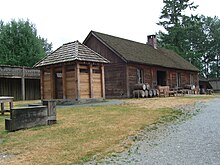Fort Langley National Historic Site
| Fort Langley National Historic Site of Canada Lieu historique national du Canada du Fort-Langley |
|
|---|---|
|
Historic Place of Canada Lieu patrimonial du Canada |
|
| Recognized since | May 25, 1923 |
| Type | National Historic Site of Canada |
| ID | 7614 |
| place | Fort Langley , British Columbia |
| Coordinates | 49 ° 10 '4.7 " N , 122 ° 34' 18.9" W |
| Recognized by | Canadian Federal Government |
| Approved by | Historic Sites and Monuments Act |
| Entry Canadian List of Monuments | |
Fort Langley National Historic Site is a historic Hudson's Bay Company trading post in what is now Fort Langley in the Canadian province of British Columbia . It is located about 40 km east of Vancouver , on the banks of the Fraser River . On May 25, 1923, it was declared a National Historic Site of Canada by the Canadian government and is now maintained by Parks Canada .
The original Fort Langley was built a few miles downstream in 1827; In 1839 it was moved to its current location. The fort served as a post for trade with the local Indian population , as a warehouse and distribution center for the Hudson's Bay Company, and as a strategic station on the first inland route from the Pacific. Originally the main focus of the fort was on fur hunting and trading . When the population of beavers and sea otters in the area was exhausted, the men of the fort switched to catching and trading salmon . They were preserved and were used to supply the inland posts and later also for the Hudson's Bay Company's trade trips to the Sandwich Islands and Australia . Other commercial goods were dried cranberries as well as wheat and butter, which were produced on the farm belonging to the fort.
After the Oregon Compromise in 1846, which set the 49th parallel as the border between the areas of the Hudson Bay Company and the United States, Fort Langley grew in strategic importance as it now occupied a key position to reach the other trading posts in the British Columbia hinterland . Agricultural production increased due to the increased demand as a result of the California gold rush .
During the Fraser Canyon Gold Rush of 1858, Fort Langley became the center of gold prospectors flowing into the Fraser River. In order to establish a state order, the crown colony of British Columbia was proclaimed in the fort on December 19, 1858 by James Douglas . This formally ended the Hudson's Bay Company's monopoly. From the 1860s and 70s the importance of the fort decreased, the buildings were only inadequately maintained and fell into disrepair. In 1886, the Hudson's Bay Company opened a newly built shop in Fort Langley, which had since developed, and gave up the actual fort on the river.
The fort currently consists of eight buildings, fenced in by palisades , which can be visited as a museum. Only the warehouse from the 1840s has been preserved in its original state, all other buildings have been reconstructed . In the summer there are daily Living History demonstrations with employees dressed in the clothes of the nineteenth-century residents. They can be seen doing traditional jobs like forging or making barrels. There are demonstrations on the weekends in spring and autumn. Daily demonstrations in November commemorate the proclamation of British Columbia at the fort.
Web links
- Parks Canada: Fort Langley National Historic Site (official website, English and French)
- Fort Langley ( English, French ) In: The Canadian Encyclopedia .
- The Children of Fort Langley website
Individual evidence
- ^ Fort Langley National Historic Site of Canada. In: Canadian Register of Historic Places. Retrieved October 17, 2013 .

